Wood is renewable and using it is good for the environment. Indiana is currently growing over three times more wood than it is harvesting. Dry wood is one-half carbon. Its use for products sequesters this carbon, helping to negate global warming.
Relatively inexpensive thin kerf band saws have made it possible to salvage small quantities of trees and for more producers to enter the market. As a result, small quantities of lumber can be produced and sold for less money than at traditional distribution yards or retail outlets.
Urban tree utilization is beneficial for the local economy and is environmentally friendly. Many consider it a "green" process because the dry wood will be used as lumber, instead of being burned or left to decompose. As a result, less carbon is released into the atmosphere.
Cassens Lumber and Live-Edge Slabs
Featured items
Walnut Live-Edge Slabs
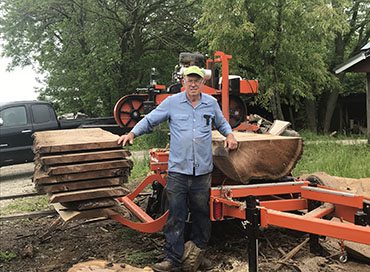
At Cassens Lumber we cut square-edged lumber and live-edged slabs from logs obtained locally. Each set of live-edged slabs is numbered and kept together to allow bookmatching and improved color uniformity.
We currently have numerous sets of wide Walnut slabs that are fresh out of our dry kilns. Be sure to visit our Slab Sales page to see the current inventory. Click on the photos to see the front and back of slabs.
Kiln-Dried Lumber
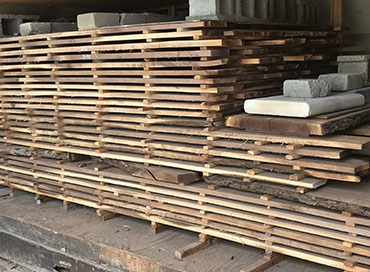
For lumber to be used indoors, it must be kiln-dried to the proper moisture content. This drying process takes several months, but is critical to keeping wood stable.
The lumber is first air dried to remove most of the moisture. It is then put into a sealed container with sticks between each course and weighted on top before being exposed to circulated dry air and heat.
Beautiful Walnut Slabs
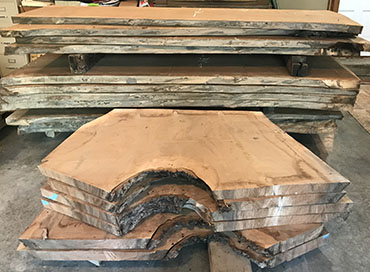
We have several exceptional wide 9/4 slabs from a large walnut tree that range from 30" to 36" wide and are 8'4" long. We have the entire log intact, so bookmatches are a possibility. We also have several beautiful 9/4 slabs from the crotchwood of the same tree that range from 48" to 55" wide and are 3' long.
Be sure to visit our Slab Sales page to see Photos of these slabs, as well as other slabs.
American Black Walnut
Walnut is the most expensive commercial North American hardwood. It constitutes only four percent of the hardwood timber available for harvest and the grading rules are greatly relaxed compared to other species like Oak or Ash. In addition, it has very distinctive sapwood which contrasts with the dark-colored heartwood. It is important to understand the grading and pricing of Walnut as it will help you select the most economical material for your application.
Grading
The National Hardwood Lumber Association publishes the Rules for the Measurement and Inspection of Hardwood and Cypress. These rules are used for the wholesale selling and purchasing of hardwood lumber. There is a "standard rule" and many species have other limitations applied. For top grade or FAS Walnut, the board width can be narrower, the length shorter, the clear-face cuttings smaller, and more cuttings are allowed as compared to the standard grade. A simpler way to look at it is that a load of top grade or FAS Walnut would be comparable to a load of No. 1 common Red Oak. In addition to the standard grades, many larger Walnut producers also sort for wide widths and limit sapwood, such as 90 percent heart on one face and 50 percent or 70 percent on the back face. Of course, these sorts increase the price of the lumber.
Sapwood
Walnut has white sapwood that can be up to three inches wide or more on some vigorous open and fast-growing trees. Wide sapwood is especially common on urban trees because they tend to be grown in the open and have large crowns. Walnut grown in a competitive forest environment will generally have sapwood in the one-to-two inch width range. Trees add wood to their outside diameter and as the tree grows larger the new wood covers old limb stubs and tends to be clear but also "sappy". This walnut will tend to have at least some sapwood on the clearest boards.
Traditional wholesale producers of Walnut "steam" the wood while it is still green. The wood is packaged tight and put into a large chamber. Live steam is injected bringing the wood temperature to about 220 degrees Fahrenheit for about two days. The sapwood darkens to about the color of Butternut and the heartwood develops a more uniform, subdued color compared to the lustrous and somewhat varied color of un-steamed heartwood. The photos below illustrate two panels of Walnut manufactured from young plantation-grown trees with wide sapwood. The panels have a clear finish. A dark stain would reduce the contrast but lessen the natural grain and color characteristics. The panel shown in the first photo is steamed and the one in the second photo is not. In the traditional market, virtually all producers steam Walnut so the sapwood does not degrade the lumber based on NHLA rules. In rough-sawn (unsurfaced) lumber, the heartwood and sapwood look similar. When you purchase Walnut lumber from the traditional distribution yards, it will be steamed. When you purchase Walnut lumber from small producers' such as Cassens Lumber LLC, it will not be steamed and you will get the lumber with its natural colors.
Pricing
Wholesale prices for semi-truck load quantities of lumber are reported each week by the Hardwood Review Weekly and the Hardwood Market Report. The prices are intended to be representative for the prior week and do not represent or predict the price of any particular shipments. All prices are based on the NHLA grades and are for semi-load quantities FOB.
On March 16, 2023, the Hardwood Review Weekly reported the price for the very top grade (FAS) kiln-dried net tally Walnut to be $4085 per thousand board feet and for 8/4 to be $5265. This is the price that a distribution yard might expect to pay for semi-load quantities and it will likely be at least doubled at the retail level. If bought on the standard grade, this shipment would include unlimited steamed sapwood as well as pieces as short as 6 feet and as narrow as 5 inches. In some cases the yards might negotiate to limit the inclusion of short, narrow pieces and even the amount of sapwood, but this will increase the value of what is shipped and, subsequently, the retail price. THE CHANCES OF GETTING A WIDE, DEFECT FREE, ALL HEARTWOOOD BOARD FROM THIS SHIPMENT ARE SLIM AT BEST. If not already sorted by the producing mill and included in the shipment, these pieces will likely be sorted out by the yard and sold at a substantial premium.
Cassens Lumber Pricing
| Our Walnut Sorts or "Grades" | All boards are 8 to 12 foot long and 6 inches and wider. Shorter stock is priced and sold by the piece. |
| Special Grade | These boards are mostly 10 to 16 inches wide, 90 percent heartwood on one face, and have very few defects, if any. Price is by the piece at $10.00 to $12.00 per board foot. |
| Best Grade #1 | These boards are 6 to 12 inches wide, mostly wide, 90 percent heartwood on one face, and few character marks. Price is $7.50 per board foot. |
| Best Grade #2 | These boards are 6 to 8 inches wide, 90 percent heartwood on one face, and few character marks. Price is $7.00 per board foot. |
| Rustic #1 | These boards are 6 to 8 inches wide, predominately heartwood, and with numerous character marks. Price is $4.00 per board foot. |
| Rustic #2 | These boards are 6 to 8 inches wide, mostly without character marks, and with unlimited sapwood. Price is $4.00 per board foot. |
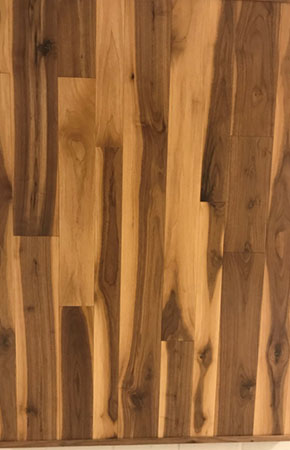
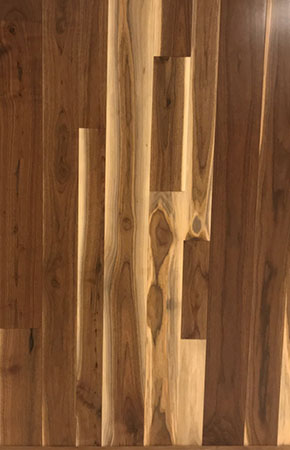
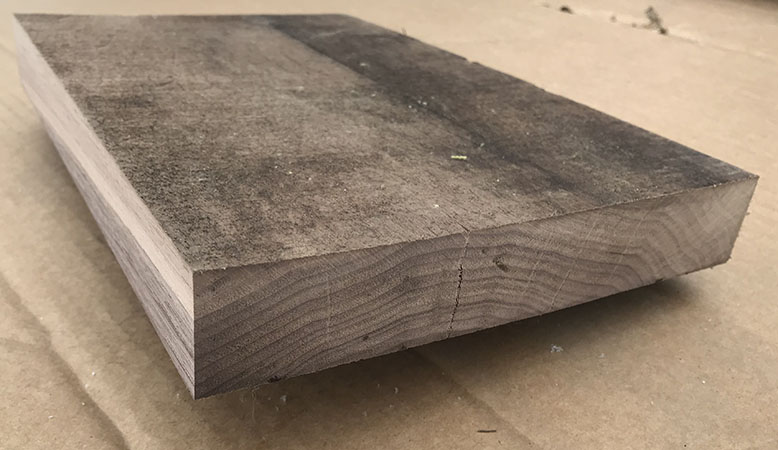
The finished panel shown in the first photo has been steamed showing how the sapwood darkens to about the color of Butternut and the heartwood develops a more uniform, subdued color compared to the lustrous and somewhat varied color of the un-steamed Walnut shown in the second photo. A short section of an unsurfaced steamed Walnut board is shown in the third photo. The recently-cut end and left edge show the lighter-colored sapwood in an arc around the darker-colored heartwood. The face of the board appears a uniform dark color even though most of it is sapwood. When this board is surfaced, it will be the lighter color of the cut edge.
Indiana Hardwood Lumber
The number one value crop in Indiana is trees and we are first in the nation in office furniture and cabinet production and second in veneer production. Indiana is known the world over for the highest quality White oak and Walnut timber. Foreign buyers come from across Europe, Japan, and, more recently, all Southeast Asian countries to purchase these and other species. Lumber, veneer and wood products manufacturing is the 6th largest industry in Indiana. Just over 20% (4.7 million acres) of the Indiana land base is forested. This forest grows 3.8 times more trees than the number being cut. The state ranks third in hardwood lumber production. The Indiana wood industry employs 50,000 people with a payroll of $1.4 billion and the regional economic impact is $17 billion.
For more details see Indiana Forest Facts.
Hardwood Veneer: Species and Defects
Hardwood veneer logs command a premium price in comparison to sawlogs and other fiber products of the forest. As an example, Settle and Gonso, Indiana
Department of Natural Resources and Division of Forestry, and Mike Seidl, Indiana State Department of Agriculture, report that
the prices paid for the highest quality delivered white oak sawlogs in Indiana averaged $1300 per thousand board feet, Doyle Scale in September 2017. In the same report,
several diameter categories and two quality classifications are used to report delivered veneer log prices. For the lower quality classification and the smallest
DIB class (13-14 inches), the price for white oak veneer logs was $1900 per MBF but increasing to nearly $4167 per MBF for 28 inch DIB logs of the highest quality.
Thus, it usually makes good economic sense to market high quality logs of the appropriate species to the face veneer industry rather then processing them for the
green wholesale lumber market.
Hardwood veneer logs fetch premium prices compared to other lumber products. Greg Hartog of Danzer Veneer Americus explains what defects veneer log buyers
are looking for in specific tree species. For more information about veneer quality,
see Factors Affecting the Quality of Hardwood Timber and Logs for Face Veneer.